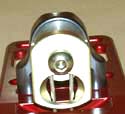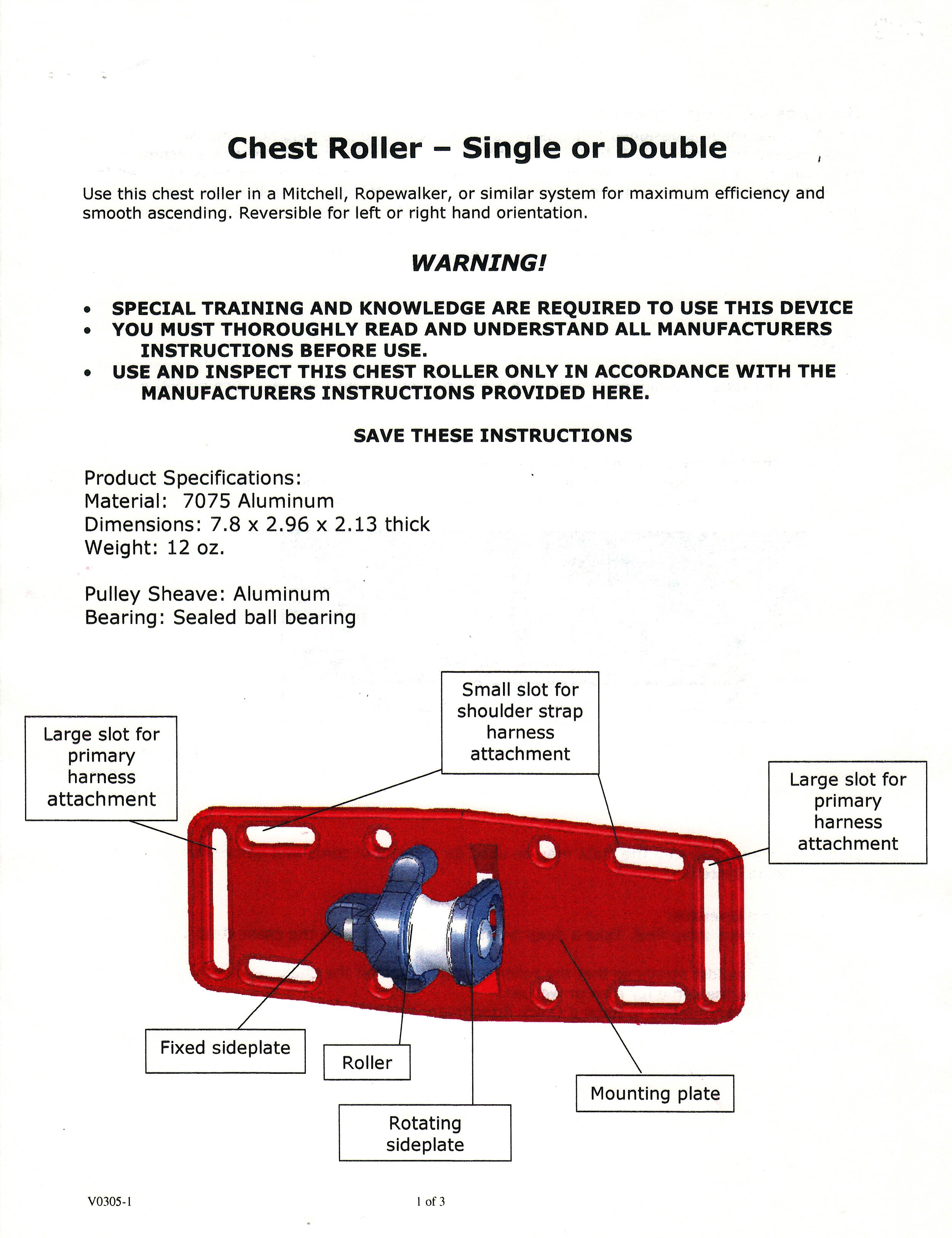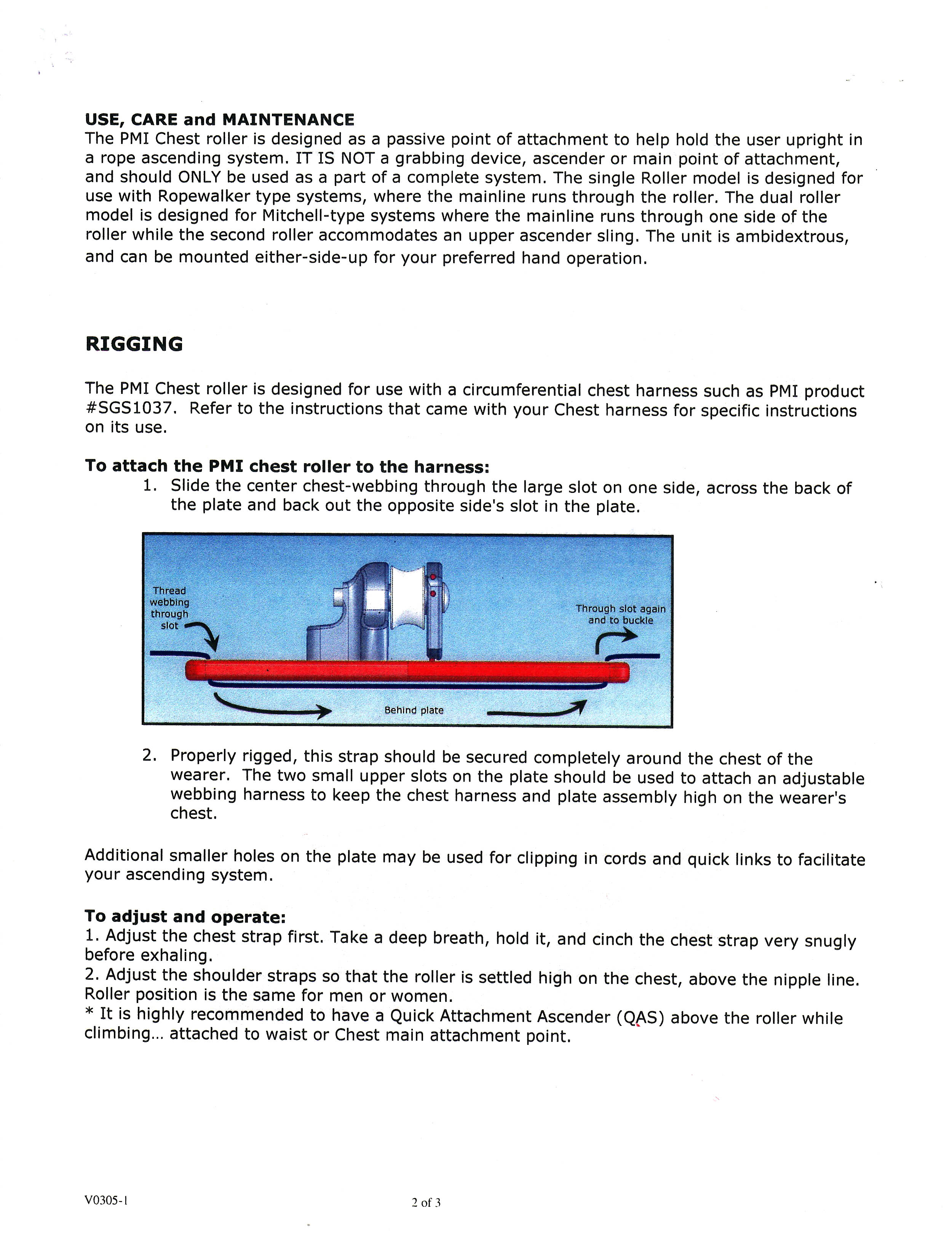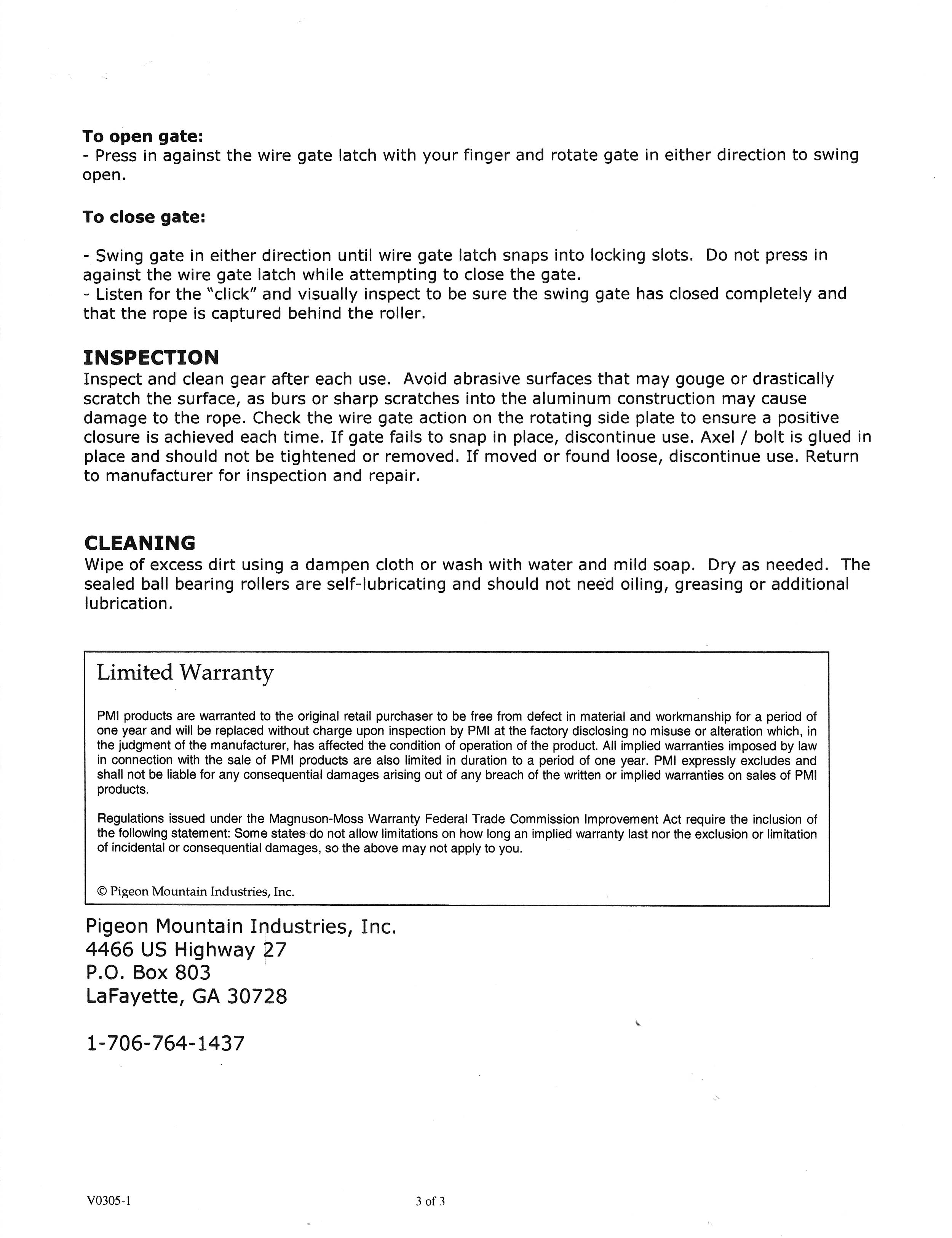Overview
[ Top
| Double Rope v. A
| Double Rope v. B
| Return to Chest Boxes
]


 Single
Rope
Single
Rope
(#818, 2653, 3777)
Technical Details
I acquired this chest box from PMI in March 2005. I acquired two more in 2017 as part of Bob Thrun’s collection.
My PMI, single rope is 75 mm. long, 197 mm. wide,
54 mm. high, and weighs 301 g. The back plate has 51 mm.
tall vertical slots for attaching the box to a chest strap and
26 mm. wide horizontal slots for attaching shoulder straps.
The PMI box consists of a back plate, support post, roller
axle, roller, and latching gate assembly. The construction made
extensive use of CNC machining. The back plate is milled from
3.5 mm. aluminum plate, possibly 7075, and anodized. Although not
obvious, the front face is milled to taper to the edges, where
the plate is only 6 mm. thick. The back has two large irregular
areas where superfluous metal was removed to a depth of 4.3 mm.
There are large (51.8 by 6.8 mm.) slots on each side for attaching
one’s main chest harness strap, and pairs of smaller (26.0 by
6.8 mm.) slots on the top and bottom for attaching the harness
shoulder slings.
The post is milled from aluminum, anodized, and bolted to the
back plate with three counter-sunk Allen screws, probably 1/4"
(6.4 mm.). An extension on the side of the post provides lateral
rigidity. It looks heavy, but the post is undercut on the other
side. There is a level area on the plate where the post attaches,
so the overall plate taper does not affect the post’s alignment.
The roller is 16.5 mm. wide and features a shallow U-shaped
rope centering groove. The roller diameter is 28 mm. at the edges
and 23.8 mm. in the center. I did not disassemble the roller to
determine the type of bearing, but it feels like it is oilite
and not a ball or roller bearing. The roller axle appears to be
a 5/15" (8 mm.) round-head Allen cap screw with full-length
thread secured against the post with a jam nut. I suspect that
the post is threaded; otherwise the axle would probably wobble.
The roller can wobble on the axle (very slightly - not significant
at all) but the axle itself is rigidly attached to the post,
 The
gate is 6.9 mm. thick, but milled from slightly thicker stock,
since there are two raised arcs on the roller side that bear against
the roller and separate the main gate body from the roller by
about 0.7 mm. Turning the gate does not turn the roller, so these
are not the main source of the roller drag. The gate latch is
a piece of 2.9 mm. spring wire bent into a squared-off U shape.
When the gate rotates closed, the wire enters a large slot in
the back plate. The slot is tapered to flex the wire until it
can engage a small projection, where the wire snaps into place,
holding the gate shut. A cutout in the gate face provides access
for releasing the wire.
The
gate is 6.9 mm. thick, but milled from slightly thicker stock,
since there are two raised arcs on the roller side that bear against
the roller and separate the main gate body from the roller by
about 0.7 mm. Turning the gate does not turn the roller, so these
are not the main source of the roller drag. The gate latch is
a piece of 2.9 mm. spring wire bent into a squared-off U shape.
When the gate rotates closed, the wire enters a large slot in
the back plate. The slot is tapered to flex the wire until it
can engage a small projection, where the wire snaps into place,
holding the gate shut. A cutout in the gate face provides access
for releasing the wire.
The PMI chest box is printed with "rock exotica"
(the manufacturer), "USA," "Patent pending,"
arrows indicating gate operation, the Reading
is Dangerous icon, "Always test gate to confirm it is
locked," and "Feb. 2005" on the caver’s right.
It is printed with "Single CHEST ROLLER," "Do
not use a chest roller for primary life support," and the
PMI logo with "PMI" on the caver’s left. A sticker on
the back reads, "WARNING" and "FOR DANGEROUS ACTIVITIES
RISK OF INJURY/DEATH CNNOT BE ELIMINATED. DO NOT USE UNLESS YOU
HAVE: READ ALL INSTRUCTIONS* RECEIVED SUITABLE TRAINING* CHECKED
GEAR BEFORE EACH USE* ACCEPTED TOTAL RESPONSIBILITY FOR YOUR SAFETY
AND GEAR SUITABILITY. ALWAYS USE A BACKUP - NEVER TRUST A LIFE
TO A SINGLE TOOL."
Tapering the front plate lightens the plate while retaining
full strength - as any engineer knows, a center-loaded beam supported
at both ends has most of its stress in the center, and should
be thicker there. This is a nice feature that shows attention
to detail. The milled areas in back lighten the plate considerably,
as does the large undercut in the front post.
The gate assembly is particularly easy to operate with either
hand. With the box right side up, I can open the gate with my
right hand by using my thumb to depress the safety, or by using
a finger of my left hand to do the same. I don't even need to
grip the gate: thumb/finger pressure suffices to rotate it. The
chest box can be turned upside-down for people who prefer using
their other hand for manipulating the gate. The gate locks closed
reliably with a distinct audible click.
The rollers turn with light resistance. I would prefer a free-running
ball or roller bearing here along with a bushing design that allowed
it to rotate more freely; however, the drag is small and probably
not to be noticed.
The note, "Do not use a chest roller for primary life
support" gets my nomination as one of the "DUH!"
message of the year. Exactly how would a chest box support my
weight, anyhow? No wonder… and by the way, in SRT, one customarily
trusts ones life to a single rope.
This box is excellent. The only real complaint I have against
this box is that I prefer double roller boxes - and that complaint
is addressed by the double roller version.
[ Top
| Single Rope
| Double Rope v. B
| Return to Chest Boxes
]


 Double
Rope, Version A
Double
Rope, Version A
(#819, 1708, 2607)
Technical Details
I acquired this chest box from PMI in March 2005, and a second from Cargo Largo in 2011. I acquired two more in 2017 as part of Bob Thrun’s collection.
This chest box is 75 mm. long, 197 mm. wide,
54 mm. high, and including the supplied harness weighs 353 g.The back plate has 51 mm.
tall vertical slots for attaching the box to a chest strap and
26 mm. wide horizontal slots for attaching shoulder straps.
Compared to the single rope version, this double rope version has a redesigned post that supports
rollers on each side. One roller is centered on the plate, the
other is offset to the climber’s right. The back plate has three
pairs of 7.2 mm. holes, giving additional choices for attaching
bungee pulleys and other peripheral items, if one chooses.
The markings on my double are the same as on the single except
for their location and that "Double CHEST ROLLER" replaces
"Single CHEST ROLLER."
Offsetting the roller to one side makes some sense. A Mitchell
climber would probably place the main line through the central
roller and the long foot sling through the offset roller. People
who climb with the long sling on the left foot might want to turn
the box upside down. Except for the printing, it is symmetrical.
On the other hand, some people might argue that a Mitchell climber
has their weight on the long foot sling as often as on the main
line so the two rollers should be symmetrically placed about
the center. Personally, I doubt that most people could tell the difference.
This may be the finest double chest roller on the market at
the time I write this. I saw no compelling reason to give up using
my Alpine Box, but this box is so good that I did. Still, one needs to be careful. Peter Jones sent me the following message in November 2010:
I have a comment on the Rock Exotica double roller chest box. I owned and loved a Fritzke Box for many years until my toxic sweat (salt)
from an unwashed harness after a caving trip led to the aluminum plate disintegrating. I replaced this in 2006 with a Rock Exotica double roller
box, which I felt was a small step up from the Fritzke, both being extremely well designed and constructed. I used it for two years and was about
to make a four day trip in Virgin Cave, a serious vertical cave in the Guads. On examining my gear a week before the start of the trip, I noticed,
to my horror, that one of the bolts that holds the right hand roller in place was hand loose, capable of coming undone with only the slightest
amount of friction and turning. I called PMI who insisted that they be the ones to examine it and determine what to do with it. I insisted that
since it was about to be used within two days that it be repaired immediately by the manufacturer. Fortunately, PMI agreed and I drop shipped it
directly to Utah for repairs. They repaired it and sent it directly to Carlsbad, NM where I picked it up on arrival.
The problem is that the bolts that hold the rollers and swing plates in position are glued in place, certainly with a high strength
adhesive, but my own experience indicates that it can literally "come unglued." The bolts are set at a specified distance into the
central post such that there is no friction on the swing plate. This means that the bolts are not set tight against one another which might add
some strength to the tightening. There is no set screw on the backside of the bolts to lock it in place, only the glue. In addition, unlike
the Fritzke Box, which uses a solid bolt all the way through, there can be an inordinate amount of torque on the individual bolts which are held
only by a few turns of the screw. If I had used the Rock Exotica Box in its unscrewed position, unbeknownst to me, it could have torqued its way
right out of the central post, leaving me in some seriously compromised position on rope.
I have written the manufacturer about my concerns over the design, but there has never been any response. I assume that it still
remains as designed. As such, I always make sure that I fully examine the bolts that hold the rollers in place before embarking on any vertical
caving trip. While I still feel that it is about the best designed double roller box on the market, it does have its problems and design flaws.
The adhesive is probably something like Loktite®. Peter still prefers the PMI (Rock Exotica) box, as do I, but his note emphasizes the importance of checking one’s gear before relying on it.
[ Top
| Single Rope
| Double Rope v. A
| Return to Chest Boxes
]


 Double Rope, Version B
Double Rope, Version B
(#3926)
Technical Details
I acquired this chest box from PMI at the 2024 NSS Convention.
This chest box is 76 mm. wide, 192 mm. high, 55 mm. thick, and weighs 886 g. It is a double channel chest box consisting of a milled plate, milled post, and double rollers with spring-loaded safety gates. The back plate has 50 mm. tall vertical slots for attaching the box to a chest strap and 26 mm. wide horizontal slots for attaching shoulder straps. The rollers are offset to one side as in the previous version. The gate mechanism consists of a spring-loaded pin that engages a hole in the plate. Two sharp buttons on each side can be pulled forward to retract the pin, allowing the gate to swing open.
This chest roller came with a harness sewn in place.
The front is printed with "DOUBLE CHEST ROLLER," "DO NOT USE A CHEST ROLLER FOR PRIMARY LIFE SUPPORT," the PMI feather logo, "PMI FOR YOUR VERTICAL WORLD." a curved double-ended arrow, "USA","←," "PMW" inside a square, and "ALWAYS TEST GATE TO CONFIRM IT IS LOCKED."
This is a prototype and so one expects to find some deficiencies. Here are some of my comments that I've given to PMI:
- The safety mechanism is awkward to use, being somewhat difficult to reach (especially compared to the previous version). The sharp points on the buttons do not provide a comfortable grip for the finger & thumb. I suggested they look at R. C. Schroeder's design.
- Unlike the previous version, this one does not have excess metal removed. While this saves cost, the resulting box is heavier than it needs to be.
- I would prefer to be able to buy the box without a harness. The supplied harness, while comfortable for some people on long free open-air drops, is excessively bulky for carrying long distances underground,
History
Version A is far superior, but it is no longer available. Rock Exotica owns the rights to that design. Several years ago they discontinued production, and they have chosen not to license the design to others. While this is their right, it is a shame that cavers no longer have access to what is perhaps the best chest box design for many applications. Recognizing the demand for double-roller chest boxes and unable to provide their former offering, PMI began developing a new design to meet market demand.
This was a prototype and only 26 were made, of which the last 19 were sold at the 2024 NSS Convention. Due to that interest, PMI is having another 30 made. PMI plans to continue prototyping and bring out an improved version. They are actively seeking feedback from those who use this version.
[ Top
| Single Rope
| Double Rope v. A
| Double Rope v. B
]

For far more content, use a larger monitor and a full-width window.
Hundreds of cell phone users complained and asked me to for a simpler, mobile friendly site. In particular, they wanted me to limit each page to a small number of pictures and minimize my use of text. This new site provides what they asked for.




